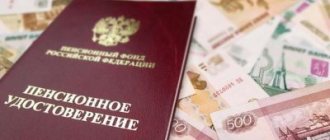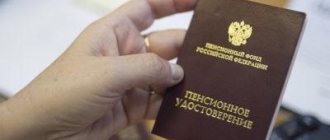What kind of funds are such financial contributions?
The funded part of the pension is a money supply that is managed by professional market participants in the interests of the insured person (in this case, a pensioner). The funded part of the pension is formed exclusively in financial terms ; no points or other systems are used here.
The receipt of funds to the owner's account is carried out through the turnover of the above-mentioned financial instruments by professional market players. If we draw an analogy, the actions of these managers can be compared with the activities of the banking system - taking money from citizens for safekeeping and putting it into circulation to accrue interest on deposits.
In the finished version, this looks like an amount that is constantly in the account of a future or already retired citizen, and the work of managers and income from cash flow is preserved as long as the given citizen is alive.
Regarding pension indexation, you should immediately be prepared for the fact that government announcements about raising pension payments will not affect the owner of the savings account. On the one hand, this may seem like a minus. On the other hand, competent managers and a deposit insurance system can bring in more income than the state could do.
IMPORTANT! The advantage of the funded part of the pension over the insurance part is that the accumulated funds can be withdrawn immediately upon reaching retirement age, before reaching this age, and also transferred as an inheritance.
A non-state pension fund is an organization that has the right to manage finances on behalf of the owner of the pension fund. This is the same professional market participant mentioned above.
Is it worth saving for retirement in a non-state pension fund?
There are different ways to save money in a non-state pension fund. If we do not consider options for the fund’s participation in government or corporate programs, the simplest method remains, when the pension is formed from contributions from the future retiree.
The NPF offers such clients to enter into an agreement on non-state pension provision, which specifies the amount and frequency of contributions to the fund. An NPF employee will help you draw up an approximate pension plan. For example, by saving 20,000 rubles monthly for 30 years, by the age of 60, taking into account the annual rate of 5%, you can accumulate 16.4 million rubles. After retirement, you will be able to spend 107,000 rubles per month for 20 years. You will have to save in rubles; legislation does not allow this in other currencies.
The money is in a special personal pension account, and income from investments is also transferred there. To operate on the stock market, a non-state pension fund enters into an agreement with a management company (there may be several of them). Typically, investment income is accrued once a year, in rare cases once a quarter. Unlike endowment insurance programs, the payment schedule in a non-state pension fund can be flexible; it is not necessary to transfer a certain amount exactly on time. But the result is not guaranteed. It depends on the client’s discipline.
According to the rules for the placement of pension reserves, NPFs have quite wide investment opportunities - they can invest up to 70% of funds in shares, and up to 80% in bonds and deposits. The funds can buy currency, securities of foreign issuers, shares of closed-end real estate funds and mutual funds for qualified investors. If the NPF were a mutual fund, then its category (stocks, bonds or mixed investments) would be impossible to determine.
In most contracts with clients, NPFs do not establish a minimum guaranteed level of income, as is customary in endowment insurance policies. Funds, in accordance with the law, must ensure the safety of funds. In other words, if the investment result turns out to be negative, the fund will compensate for the losses from its own funds.
During a crisis, this condition favorably distinguishes non-state pension funds from mutual funds or a portfolio of shares, for example. Over the past year, according to the head of the National Association of Pension Funds (NAPF) Konstantin Ugryumov, these losses averaged 35%. This did not affect the accounts of depositors in any way (see table). Moreover, some NPFs accrued income on accounts for 2008 of up to 15% per annum. The fund will cover losses from future income - on average, the stock market brought 40% per annum in the first half of the year, but the profitability for NPF investors will be significantly lower.
Thanks to this property, a pension contract is essentially similar to capital protection products - there can be no losses, and income is theoretically unlimited. Therefore, NPFs, in most cases, are reluctant to talk about the size of the future pension or the total amount of savings - it is impossible to determine it, just as it is impossible to predict the return of the stock market a couple of decades in advance.
There is also a minus: clients of most NPFs will not be able to get an intelligible answer to the question about the strategy for investing their funds or choose how much of the amount they would like to invest in stocks or bonds. All this is at the discretion of the NPF and the management company. After all, private clients were initially not very interesting to funds; for the most part, non-state pension funds never learned how to create and sell their products.
Unlike insurers, NPFs do not have annoying agents who need to pay commissions. Although you will still have to pay - to the fund and the management company that invests the funds. According to the law, a non-state pension fund can charge a depositor up to 3% of his pension contributions immediately after they are received. The remaining commissions are charged based on the results of work for the year. The remuneration of the management company and the special depositary is up to 1.1% of the value of the assets transferred to management and up to 10% of the income received. The fund itself can claim 15% of the income received.
Not all funds have maximum commissions. VTB Pension Fund, for example, does not charge a commission when transferring contributions. Commissions of NPF "Raiffeisen" for one-time contributions of more than 10,000 rubles are 2%, more than 100,000 rubles - 1.5%. The minimum that a future pensioner can receive at the end of the year is two-thirds of the investment result. However, the funds show their investors the final return after all commissions.
After retirement, you can enter into an agreement with the NPF on monthly payments, although you can withdraw the entire accumulated amount. In both cases, you will have to pay tax (currently 13%) on the income that the fund has earned over the entire period.
How reliable is NPF? In addition to the ban on reducing pension capital, the funds have another guarantee. By concluding an agreement with a non-state pension fund, you may find yourself in the pool of future pensioners from Gazprom, Lukoil, Russian Railways or some other large company - this is a certain degree of social protection.
Is it necessary to transfer to a non-state pension fund?
This is a rather subjective question and must be answered based on the wants and needs of the account holder. As such, there is no obligation to transfer the funded part of the pension to a non-state pension fund. And if you do not take care of your future savings on your own, the state will take this issue upon itself and transfer all available funds to a controlled organization, where the capitalization from the circulation of money will be somewhat less.
If you transfer your funded pension account to a non-state pension fund, then there is a real chance that you will end up with a significantly larger amount than the state can offer. Read about how to make a transfer in our material.
In what ways can I transfer to independent organizations?
To transfer your pension savings to a non-state pension fund, you must contact the organization in one of the following ways :
- personal appeal;
- application through the State Services portal;
- sending a registered letter via Russian Post;
- through a proxy (the power of attorney is issued by a notary).
Important! The transfer procedure itself is free, but you should first weigh all the pros and cons of transferring funds to a non-state pension fund.
You can apply once a year until December 31 of the year preceding the transfer of the funded part to the NPF (that is, if you apply in January 2020, the transfer will occur only from the beginning of 2020).
procedure for filling out an application for transfer is completed in one day :
- An application is made to the desired NPF.
- An application is written to transfer savings from the state to a non-state pension fund.
- The application is registered.
- The applicant is given a receipt indicating the documents were accepted.
What happens if you don't translate?
If for some reason a citizen has not transferred his funded pension to a non-state pension fund, then this is not a big tragedy. The pension fund will simply direct the funded part of the pension to its own structures (as a rule, Vnesheconombank, a state management company, does this).
You should not believe various sources that claim that all money not transferred to the NPF will be burned.
It is enough to contact the Pension Fund of the Russian Federation, where a consultant over the phone will be able to competently explain that these are all fictions that should not be paid attention to. The money of future retirees will not go to waste.
The difference will be tenths of a percent of the turnover. On the other hand, the insured person receives almost completely guaranteed security of preserving his funds, since this GUK can neither go bankrupt nor go bankrupt. The same cannot be said about other market participants.
“The plan to abolish funded pensions smacks of a scam”
According to current legislation, the expected period for payment of a funded pension is calculated based on data on the number of men and women who have reached retirement age. For the compulsory pension insurance system, a so-called “survival period” is established - that is, the time during which the funded pension is paid. Starting from 2020, the figure, initially set at 19 years, is increasing annually and in 2021 it will be 22 years.
The FNPR believes that this practice reduces the size of the pension provision of the insured and “discredits the very idea of a funded pension.” In this regard, the federation requests to stop the practice of increasing the expected payment period and to remove the funded component from the compulsory pension insurance system.
Let us remind you that pension savings have been paid to pensioners since 2012. In general, the amount of such a pension is low compared to the amount of the main pension - the old-age insurance pension. According to the Pension Fund of Russia (PFR), in 2020 the average funded pension was 956 rubles. per month.
Expert opinions
Alexander Safonov, professor at the Financial University under the Government of the Russian Federation: “Let's start with why the trade unions came up with such a proposal. In 2001, a funded system was introduced in Russia. She assumed that 6% of the wage fund would be transferred to the current account of each employee born no earlier than 1967 to state pension structures. This made it possible to accumulate certain funds, and the system was fully justified. After 2014, not a penny goes to savings accounts. Accordingly, the question arises: is it possible to accumulate anything in a situation where there are no new contributions? Young workers who entered the labor market after 2020 are definitely not accumulating anything. Those who were saving also stopped saving - with the exception of funds from non-state pension funds earned as investment income.
However, if you look at the economics of such a system, the following emerges: in order for a person to receive an average pension of 15 thousand rubles, which now exists in the usual solidary compulsory insurance system, his monthly salary must be 175 thousand rubles. Then those 6% deductions allow you to form the desired figure and reach the stated parameters. Otherwise, the amount of additional payment of income from the savings system will be lower. Even to pay half of this amount, 7.5 thousand rubles, requires a salary above 80 thousand rubles. In Russia, not everyone can boast of such a monthly income, to put it mildly.
Now, as a result of the coronavirus crisis, there is a drop in investment income and the question arises: is it possible in such conditions in the long term to add some significant funds to the amount that the non-state pension fund transfers to citizens? Two years ago, the government began a discussion about the need to transfer the mandatory funded pension system to some other guaranteed pension product. However, no concrete decisions have been made so far. It is obvious that the system must be transformed: either abolished, and the savings that citizens have already made will be managed individually in the non-state pension insurance system. Or the state will create an alternative that will allow the employee to save himself in exchange, for example, for receiving certain tax benefits.
The trade unions’ proposal is an attempt to find a status quo in the current dilemma: on the one hand, legally the funded system exists, on the other hand, from a practical point of view, it is ephemeral.”
Oksana Dmitrieva, deputy of the Legislative Assembly of St. Petersburg, Doctor of Economic Sciences: “Contributions to the funded part of the pension have not been transferred since 2014. On the other hand, citizens born in 1967 and those born later contributed money to the funded part starting in 2002. It is not yet clear where this pension portion of 6% went. Almost everyone has forgotten about this money, but a significant amount has accumulated over the years - more than 2 trillion rubles. At the same time, no one is going to pay this money en masse. Citizens of these years of birth have not yet retired due to changes in pension legislation.
On the one hand, I agree that there should be no savings element and all mandatory contributions should go to the insurance part of the pension. But, on the other hand, if you are guided by this thought, you may never see the previously accumulated 2 trillion rubles. The return on this money is significantly less than the insurance part of the pension. This smacks of a scam that needs to be dealt with in detail. And it arose because the pension system is seriously confused.”
Mark Goikhman, chief analyst at TeleTrade: “The abolition of the funded part of the pension, even if implemented, will probably not mean the confiscation of previously deposited funds. We are talking about the cessation of mandatory contributions in the future, which are deducted by employers in the amount of 6% of wages.
But the funds in savings accounts are now “frozen” and are not replenished from these deductions. This is, indeed, depriving future retirees of part of their money, which everyone seems to have accepted. The abolition of the funded part of the pension would simply stop mandatory contributions and transfer them to a voluntary basis. From the perspective of future retirees, this would be fair. The person himself would determine how much and where to save for his future old age. After all, this is exactly what happens in the case of voluntary contributions to non-state pension funds, insurance companies, and bank pension accounts.
But it is precisely this voluntariness that is categorically unacceptable for the state pension system. After all, many people would refuse such transfers, since there is not enough income to live “here and now.” In the meantime, contributions of 6% are mandatory, and they do not go to the accounts of the paying employees themselves, but are used by the state for current pension payments to other people - current pensioners. This is an important source of replenishment for the Pension Fund, without which its deficit will increase sharply.
The abolition of the funded part of the pension now could mean the abolition of receiving pensions for a huge number of people. The state cannot do this. It cannot “unfreeze” existing savings accounts for employees - for the same reason. After all, then the funds from contributions will again begin to accumulate on them, belong to the employees, and it will be impossible to direct this money to current pensions for the current elderly.”
Nikita Maslennikov, head of the “Finance and Economics” department at the Institute of Contemporary Development : “The FNPR initiative leaves an ambivalent impression. The current efficiency of the funded component of the state pension insurance system is unsatisfactory. The main problem is, first of all, the freezing of the funded part of the pension, which is why the necessary funds do not flow into the industry. Therefore, even under existing conditions, the effectiveness of its work is far from perfect.
However, this does not mean that it is necessary to completely abandon the savings component. Literally, the FNPR proposal sounds like this: the funded component of the pension system does not justify itself, so it should be excluded. But the question arises: what to offer instead? There are no guarantees that the implementation of the trade union initiative will improve the financial situation of retired Russians.
The global perspective for the development of the pension system is that, in parallel with the insurance part, it is necessary to build an efficient and very powerful savings structure. In what form it will be built is another question. It must exist, because without it our country will never achieve higher standards of pension provision for citizens.
Therefore, it is impossible to simply agree with the FNPR proposal. The government needs to clearly define what will happen in the future with the funded part, in what form and when it will be restored. This is extremely necessary to restart the entire storage system. Of course, first of all, it must be voluntary, but without the obligatory part, reincarnation is impossible. Therefore, the main positive aspect that I see in the trade unions’ proposal is a timely reminder to the government that it is time to decide in what form the pension system will exist in Russia.”
Is this investment profitable?
Yes, it's profitable. There are quite a large number of non-state pension funds that are in close connection with government agencies. The difference, as before, lies only in the conditions for calculating the bonus part of the funded pension. Somewhere it will be a little more, somewhere a little less.
In addition, the funded part of the pension can be managed independently , and if at the time of the death of the policyholder there is money in the account, then his relatives will be able to easily receive these funds for their management. This is not possible with an insurance pension.
In addition, it is not only profitable, but also safe. All relations between the state, non-state pension funds and clients are regulated by Federal Law of December 28, 2013 N 424-FZ “On funded pensions”.
If any controversial issues suddenly arise, the judicial authorities are more likely to make a decision that is positive for the client based on the existing regulatory act.
Advantages and disadvantages
Benefits of NPF:
- It is possible to directly influence the amount of future payments.
- It is possible to receive income from several sources at once.
- Future retirement is easier to predict.
- Pension contributions are tax-free, so nothing is lost.
- All NPFs are carefully controlled by special government bodies.
- Management companies (NPFs) can invest exclusively in assets that have proven their reliability and only in Russia.
- There is always the possibility of transferring funds from one non-state pension fund to another.
Disadvantages of NPF:
- The future is quite vague. Even despite all the positive assurances from politicians and economists, depositing money into a non-state pension fund will be considered a long-term investment. In addition, experts predict that the key players in this market will shrink by about half. The money must be brought now, but there is no guarantee that it will be paid as promised.
- Fraud. Many dubious companies often cover up their illegal activities with the guise of a pension fund, but in reality it turns out that they simply appropriate all the financial resources received from the population and hide, as a rule, abroad. In order to protect yourself from scammers, you need to carefully select an organization, check its details through government portals, and not pay attention to the unrealistically high percentage of promised profits.
What do you need to know when making a practical choice?
Some of the working practical recommendations include the following:
- Do not go where the percentage of promised profit is much higher than the market average. Here scammers try to play on the client’s feelings of greed.
- View reviews online. If the reviews are only good, this should be alarming. Most likely, this is all falsification.
- Carefully check the company details, which should be freely available in the NPF register. This can be done on the official website of the Pension Fund. If the register does not contain any information about the non-state pension fund of interest, then there is a high probability of the illegal origin of this enterprise.
- Prefer large, well-known financial organizations to small private associations. In large companies, income may be slightly lower, but the security that the insured person will actually receive his money upon reaching retirement age is ten times higher (how to receive your funded part of a pension from a non-state pension fund is discussed here).
Do you want to transfer the funded part of your pension to a non-state pension fund? Then you need to pay special attention to the choice of organization. On our website you can find detailed information about the programs and conditions of such non-state pension funds as VTB-24 and Sberbank.
What are the prospects?
GPP is already the third version of the funded pension system.
The previous two: individual pension capital and funded pensions have encountered difficulties. According to surveys, more than two-thirds of Russians do not want to contribute part of their earnings to retirement. According to Anton Tabakh, the GPP was developed to tick off the plan of the president and the outgoing head of government: “In my opinion, in the form in which it is being proposed, it will not be too effective and too popular. At the insistence of the social bloc, auto subscription was removed from it, and without this, such pension systems do not work well.”
Alexander Tsyganov believes that the new system has not only disadvantages: “The advantages of GPP are financial discipline and the fact that previously frozen savings can be transferred to NPFs. But I don’t think this program will be very popular in the first year. What happens next will depend on incentives and trust in the system.”










